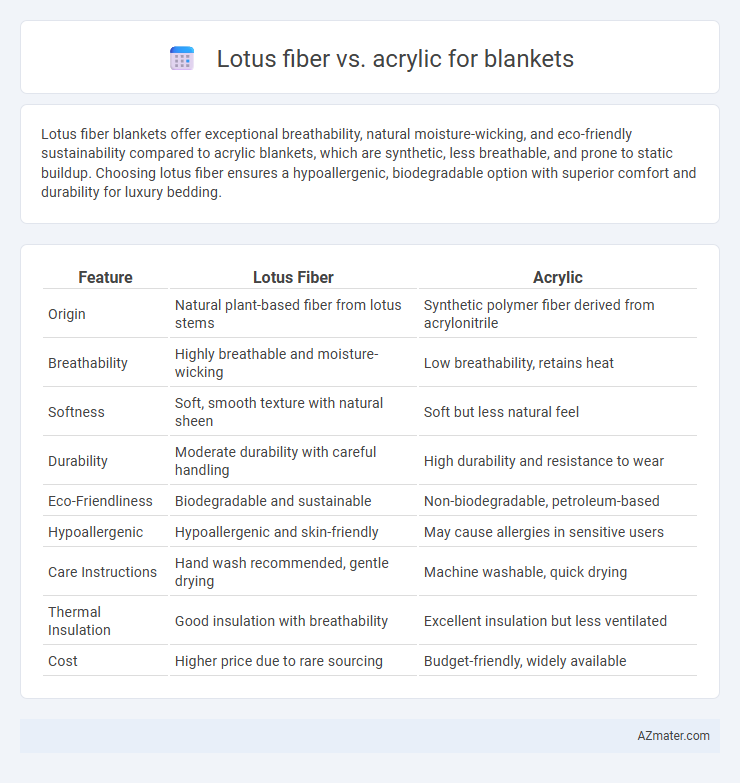Lotus fiber blankets offer exceptional breathability, natural moisture-wicking, and eco-friendly sustainability compared to acrylic blankets, which are synthetic, less breathable, and prone to static buildup. Choosing lotus fiber ensures a hypoallergenic, biodegradable option with superior comfort and durability for luxury bedding.
Table of Comparison
| Feature | Lotus Fiber | Acrylic |
|---|---|---|
| Origin | Natural plant-based fiber from lotus stems | Synthetic polymer fiber derived from acrylonitrile |
| Breathability | Highly breathable and moisture-wicking | Low breathability, retains heat |
| Softness | Soft, smooth texture with natural sheen | Soft but less natural feel |
| Durability | Moderate durability with careful handling | High durability and resistance to wear |
| Eco-Friendliness | Biodegradable and sustainable | Non-biodegradable, petroleum-based |
| Hypoallergenic | Hypoallergenic and skin-friendly | May cause allergies in sensitive users |
| Care Instructions | Hand wash recommended, gentle drying | Machine washable, quick drying |
| Thermal Insulation | Good insulation with breathability | Excellent insulation but less ventilated |
| Cost | Higher price due to rare sourcing | Budget-friendly, widely available |
Introduction: Choosing the Right Blanket Material
Lotus fiber blankets offer exceptional breathability and natural moisture-wicking properties, making them ideal for sensitive skin and warmer climates. Acrylic blankets provide durability, vibrant color retention, and affordable warmth, suited for budget-conscious consumers seeking easy-care options. Comparing these materials helps determine the best balance between comfort, sustainability, and maintenance for your specific needs.
Overview of Lotus Fiber and Acrylic
Lotus fiber is a natural, eco-friendly material derived from lotus stems, valued for its softness, breathability, and moisture-wicking properties, making it an ideal choice for blankets in warm climates. Acrylic is a synthetic fiber known for its affordability, durability, and resistance to mildew and wrinkles, frequently used in blankets for its warmth and ease of care. While lotus fiber blankets provide sustainable comfort with a unique texture, acrylic blankets offer budget-friendly warmth and long-lasting performance.
Composition and Manufacturing Process
Lotus fiber blankets are crafted from the inner bark of lotus stems, relying on an eco-friendly, labor-intensive extraction process that involves hand-stripping and drying the fibers, resulting in a natural, biodegradable fabric. Acrylic blankets are produced through a chemical polymerization process where synthetic fibers derived from acrylonitrile are spun into yarn, offering a durable and low-cost alternative. The organic origin and sustainable harvesting of lotus fiber contrast with the synthetic, industrial manufacturing of acrylic, affecting texture, breathability, and environmental impact.
Softness and Texture Comparison
Lotus fiber blankets offer a uniquely soft texture that becomes silkier with use, providing natural breathability and a gentle, smooth feel against the skin. Acrylic blankets, while often initially soft, tend to have a synthetic texture that can feel less breathable and may become less comfortable over time due to static buildup. The natural fibers in lotus blankets contribute to a more luxurious drape and moisture-wicking properties, contrasting with acrylic's typically denser and less absorbent texture.
Warmth and Insulation Qualities
Lotus fiber offers superior warmth and natural insulation due to its hollow microfibers that trap heat effectively, making it ideal for cozy blankets. Acrylic blankets provide good insulation and warmth comparable to wool but can sometimes lack breathability, leading to less temperature regulation. Choosing lotus fiber blankets ensures a more sustainable and thermally efficient option for cold weather.
Durability and Longevity
Lotus fiber blankets offer exceptional durability due to their natural strength and resistance to wear, making them ideal for long-term use. Acrylic blankets, while affordable and soft, tend to pill and degrade more quickly under frequent washing and heavy use. The superior longevity of lotus fiber blankets ensures they maintain texture and integrity far beyond the typical lifespan of acrylic alternatives.
Hypoallergenic and Skin-Friendliness
Lotus fiber blankets offer superior hypoallergenic properties due to their natural antimicrobial and moisture-wicking abilities, making them ideal for sensitive skin and allergy sufferers. In contrast, acrylic blankets, being synthetic, may cause irritation or allergic reactions in individuals with sensitive skin. Lotus fiber's breathable and skin-friendly texture enhances comfort, reducing the risk of eczema or rashes compared to acrylic alternatives.
Eco-Friendliness and Sustainability
Lotus fiber is highly eco-friendly, derived from natural lotus stems with minimal water and pesticide use, and it is biodegradable, reducing environmental impact. Acrylic, a synthetic fiber made from petroleum-based products, is non-biodegradable and contributes to microplastic pollution during washing. Choosing lotus fiber blankets supports sustainable farming practices and lowers carbon footprints compared to acrylic alternatives.
Cost and Accessibility
Lotus fiber blankets typically cost more due to the labor-intensive process of extracting and weaving natural lotus fibers, making them less accessible in mainstream markets. Acrylic blankets offer a more affordable and widely available option, produced through synthetic manufacturing methods that lower production costs. Consumers seeking budget-friendly and easily accessible blankets often prefer acrylic over the premium-priced lotus fiber alternatives.
Final Verdict: Which Blanket Material is Best?
Lotus fiber blankets offer superior breathability, natural hypoallergenic properties, and eco-friendly sustainability compared to acrylic, making them ideal for sensitive skin and warmer climates. Acrylic blankets excel in durability, vibrant color retention, and affordability but may lack the moisture-wicking and thermal regulation benefits of lotus fiber. For a premium, breathable, and environmentally conscious choice, lotus fiber blankets provide the best overall comfort and performance.

Infographic: Lotus fiber vs Acrylic for Blanket
 azmater.com
azmater.com